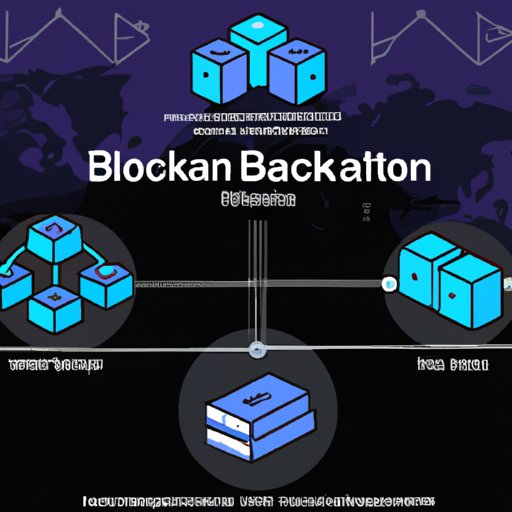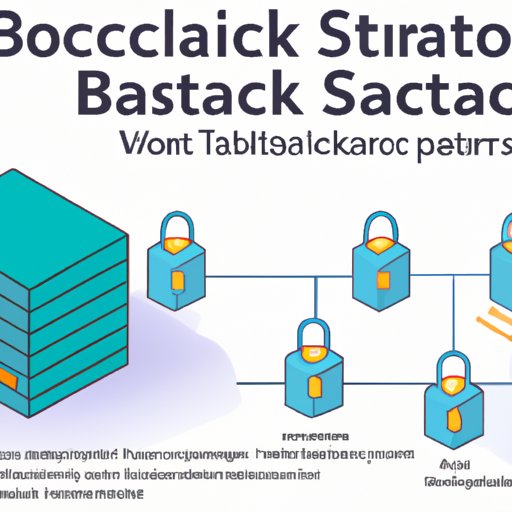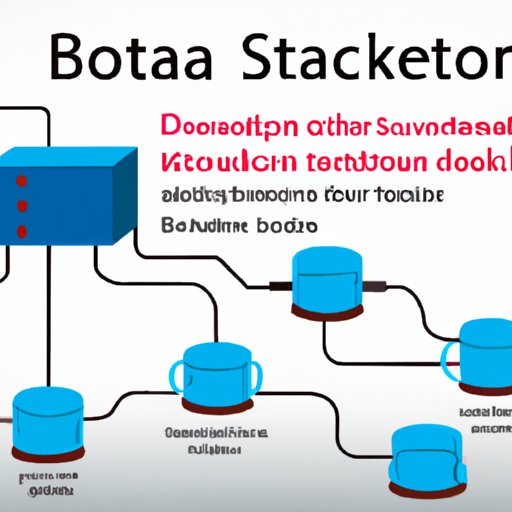Introduction
Blockchain technology has revolutionized the way we store and share data. By allowing users to securely store and transfer data without relying on a centralized authority, blockchain technology has enabled users to transact with each other in a secure and efficient manner. But what exactly is blockchain data storage, and where is it stored? This article will explore these questions and more as we dive into the world of blockchain data storage.
Exploring the Concept of Blockchain Data Storage
Before we look at where is blockchain data stored, let’s first examine what is blockchain data storage. In basic terms, blockchain data storage is a method of storing digital information or data using distributed ledger technology (DLT). DLT is a type of technology that allows for the secure sharing of data across multiple computers or devices. The data is stored in blocks which are linked together in a chain-like structure. Each block contains all the necessary data needed to complete a transaction or process, and each block is cryptographically secured.
The main advantage of blockchain data storage is that it is highly secure and cannot be altered or deleted. This makes it ideal for storing sensitive information such as financial records or healthcare data. Additionally, blockchain data storage is transparent and traceable, meaning all users can view the history of a transaction or process from start to finish.

Examining the Different Types of Blockchain Data Storage
Now that we have an understanding of what is blockchain data storage, let’s take a closer look at the different types. There are two main types of blockchain data storage: on-chain storage and off-chain storage.
On-Chain Storage
On-chain storage is the most common type of blockchain data storage. It involves storing data directly on the blockchain, meaning that all users of the network can view and verify the data. On-chain storage is typically used for recording transactions, such as payments or transfers, and is the most secure form of blockchain data storage.
Off-Chain Storage
Off-chain storage is a type of blockchain data storage that does not involve storing data directly on the blockchain. Instead, the data is stored on a separate, private server or database. Off-chain storage is typically used for large amounts of data that need to be kept confidential. It is less secure than on-chain storage, but it can be used for tasks such as data analysis or machine learning.

How to Securely Store Blockchain Data
Storing data on a blockchain is only as secure as the methods used to protect it. To ensure that data is secure, there are several steps that can be taken. These include using encryption, digital signatures, and access controls.
Benefits of Using Encryption
Encryption is a method of protecting data by transforming it into a code that can only be read by those who possess the correct key. This makes it difficult for unauthorized users to access the data. Encryption can also be used to verify the authenticity of a transaction or process, as it ensures that any changes made to the data are easily identifiable.
Use of Digital Signatures
Digital signatures are another way to ensure that data stored on a blockchain is secure. A digital signature is a unique code that is generated when a user signs a transaction or process. This code can then be used to verify that the user is who they say they are, and that the data has not been tampered with.
Implementing Access Controls
Access controls are another important part of securely storing data on a blockchain. Access controls are used to restrict who can view or modify data. For example, access controls can be used to limit the amount of data that a user can view or change, or to ensure that only certain users can make changes to the data.

Analyzing the Benefits of Blockchain Data Storage
Now that we understand the basics of how blockchain data storage works, let’s take a look at some of the benefits it offers. Blockchain data storage provides increased transparency and traceability, improved security, and reduced costs.
Increased Transparency and Traceability
One of the biggest advantages of blockchain data storage is that it allows for increased transparency and traceability. All users of the network can view the data stored on the blockchain, ensuring that no one user can manipulate the data for their own benefit. Additionally, all transactions and processes are recorded and can be traced back to their source, making it easier to identify fraudulent activity.
Improved Security
Another benefit of blockchain data storage is improved security. As mentioned previously, data stored on a blockchain is encrypted and secured using digital signatures and access controls. This makes it much more difficult for hackers or malicious actors to gain access to the data.
Reduced Costs
Finally, blockchain data storage can help reduce costs associated with storing data. Since data is stored on a distributed network, there is no need for expensive hardware or software. Additionally, since data is shared across multiple computers, there is no need to purchase additional storage space.

Understanding the Challenges of Blockchain Data Storage
While there are many benefits to using blockchain data storage, there are also some challenges that must be addressed. These include scalability, cost, and privacy.
Scalability
One of the biggest challenges facing blockchain data storage is scalability. As the number of users on the network increases, so too does the amount of data that needs to be stored. This can lead to slower transaction times and higher fees, as more computing power is required to process the data.
Cost
Another challenge associated with blockchain data storage is cost. While the cost of storing data on a blockchain is lower than traditional data storage solutions, it is still higher than some other forms of data storage. Additionally, the cost of using blockchain technology can vary depending on the size of the network and the complexity of the data.
Privacy
Finally, privacy is another challenge associated with blockchain data storage. Since all transactions and processes are visible to all users on the network, there is a risk that sensitive data could be exposed. To mitigate this risk, users must take measures to ensure that their data is securely encrypted and stored.
Comparing Traditional and Blockchain Data Storage
Now that we have explored the different types of blockchain data storage and their associated benefits and challenges, let’s compare them to traditional data storage solutions. Traditional data storage solutions such as databases and file systems are often used to store large amounts of data. However, they are vulnerable to manipulation and tampering, and data stored on them can be difficult to track and trace.
Advantages of Blockchain Data Storage
In comparison, blockchain data storage offers several advantages over traditional data storage solutions. As mentioned previously, blockchain data storage is highly secure and transparent. Additionally, data stored on a blockchain is immutable, meaning that it cannot be altered or deleted. Furthermore, data stored on a blockchain can be easily tracked and traced, making it easier to identify fraudulent activity.
Disadvantages of Traditional Data Storage
Traditional data storage solutions also have their disadvantages. They are vulnerable to manipulation and tampering, and data stored on them can be difficult to track and trace. Additionally, traditional data storage solutions are not as secure as blockchain data storage and can be vulnerable to hacks or data breaches.
Introducing the Future of Blockchain Data Storage
As blockchain technology continues to evolve, so too does the potential for blockchain data storage. There are several areas where blockchain technology could have a major impact in the future, including supply chain management, healthcare, and finance. Additionally, developments in technologies such as artificial intelligence and machine learning could help to improve the efficiency and security of blockchain data storage.
Potential Areas of Impact
One of the potential areas where blockchain data storage could have a major impact is in supply chain management. By allowing businesses to securely store and track data related to their products and services, blockchain data storage could help to reduce costs and increase transparency. Additionally, blockchain data storage could be used to verify the authenticity of products, helping to reduce fraud and counterfeiting.
Developments in Technology
In addition to its potential applications in supply chain management, blockchain data storage could also be used in other areas such as healthcare and finance. Advances in technologies such as artificial intelligence and machine learning could help to further improve the efficiency and security of blockchain data storage. For example, AI could be used to identify fraudulent transactions or detect anomalies in data.
The Role of Artificial Intelligence
Artificial intelligence (AI) could also play an important role in the future of blockchain data storage. AI could be used to monitor and analyze data stored on a blockchain, helping to identify potential threats or vulnerabilities. Additionally, AI could be used to automate certain processes, such as verifying the authenticity of transactions or identifying suspicious activity.
Conclusion
Blockchain data storage is a powerful and secure way to store and share data. It offers increased transparency and traceability, improved security, and reduced costs compared to traditional data storage solutions. Additionally, advancements in technologies such as artificial intelligence and machine learning could help to further improve the efficiency and security of blockchain data storage in the future.
Summary of the Article
This article explored where is blockchain data stored. It discussed the concept of blockchain data storage, examined the different types, looked at how to securely store data, analyzed the benefits, understood the challenges, compared traditional and blockchain storage, and introduced the future.
Further Reading
For more information about blockchain data storage, check out our other articles on the topic: What is Blockchain Data Storage?, Understanding the Benefits of Blockchain Data Storage, and Exploring the Challenges of Blockchain Data Storage.
(Note: Is this article not meeting your expectations? Do you have knowledge or insights to share? Unlock new opportunities and expand your reach by joining our authors team. Click Registration to join us and share your expertise with our readers.)
